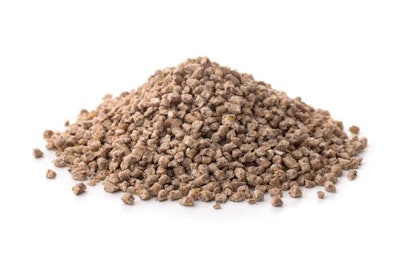
A new publication from Europe’s feed industry organization shows trends in compound feed production in the region over recent years, including a gradual expansion in average output from fewer feed mills.
Compound feed production in the 28 states of the European Union (EU-28) amounted to 164.8 million metric tons (mmt) in 2018, according to the European Feed Manufacturers Federation (FEFAC).
In its latest Feed and Food Statistical Yearbook 2018 — just released — the organization sets out a wide range of data covering the region’s compound feed industry since 2002, as well as on meat production and livestock populations.
Looking at overall trends in feed output in the EU, production was 29% higher in 2018 than in 2010.
Over this period, expansion in feed output was noticeable in newer member states — such as Lithuania (+56%), Poland (+42%), and Bulgaria (+23%).
While most of the longer-standing member states registered increases of a few percentage points in terms of volume, others recorded significant increases. Compared to the base year, production was higher in the United Kingdom (+44%), Austria (+26%) and Spain (25%). These increases likely reflect the effects of a prolonged summer drought in 2018. The lack of rainfall and high temperatures held back pasture growth, and consequently increased demand for cattle and sheep feeds.
Europe’s top feed producers
Top countries in EU-28 in terms of feed output in 2018 were Spain (24.3 mmt), Germany (23.8 mmt), France (20.8 mmt), the U.K. (16.8 mmt), the Netherlands (14.9 mmt), and Italy (14.0 mmt).
FEFAC also provides data on feed production in some non-EU countries. In 2018, Turkey produced 24.1 mmt, Norway 3.9 mmt, Switzerland 1.6 mmt, and Serbia 1.2 mmt.
Number of registered feed mills in EU
There were 3,715 feed mills in EU-28 countries in 2018, according to FEFAC’s latest estimates. In 2008, there were 4,012 production units.
In 2018, Spain had the most feed mills (804), followed by Italy (417), the U.K. (380), France (314), Hungary (302) and Germany (299).
Average production across the EU for these mills was just under 45,000 metric tons in 2018. This was slightly higher than the previous year, which ended a prolonged period of declining throughput since about 2004.
EU feed production by species
In the publication, FEFAC presents its own data on the breakdown of feed production in the EU-28 by animal species.
Of the total 164.8 mmt of feeds produced in 2018, poultry accounted for 55.7 mmt feed, pigs for 51.5 mmt, and cattle for 47.9 mmt. Also included in the total were 1.1 mmt of milk replacers and 8.6 mmt of feeds for other species.
Total output in 2018 was 2.2% above the previous year’s figure.
Ingredient use in EU compound feeds
Half of the raw materials used in feeds comprised cereal grains, according to the FEFAC report. A further 26% came from oilseed cakes and meals, and 12% was coproducts from the food and bioethanol industries.
Other minor ingredients by weight were oils and fats (2%), pulses, dried forage and dairy products (each 1%), and 3% was minerals, vitamins and other additives.
EU feed production in 2018 required the import of 54.3 mmt of ingredients, including 24.4 mmt of oilcakes and meals and 21.3 mmt of feed grains.
A recent study by the European Commission revealed that the EU feed industry imported more protein ingredients for inclusion in livestock feeds in 2018-19 than in the previous year.
These published statistics exclude Luxembourg, Greece and Malta. As relatively small markets, they support few suppliers, and so data could reveal commercially sensitive information. Also excluded from this publication are statistics on pet food.
FEFAC’s Feed and Food 2018 is available to download free of charge as a PDF file from the organization’s website.
For 2019, FEFAC has provisionally estimated compound feed output from the 28 EU member states at 161.7 mmt. This represents a decline of just under 1% compared to the previous year.
Overall, poultry feed output was forecast to be stable in 2019, while production of cattle and pigs feeds were expected by FEFAC to be down on the 2018 figures. The drop in demand was marked for cattle feed in some countries. This likely reflects the summer weather pattern, which was generally more supportive of pasture growth than in the year before.















